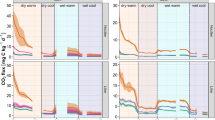Abstract
The earthworm population in a winter cereal field in Ireland was studied over a 3-year-period and its effects on soil and N turnover were assessed. The mean annual population density was 346–471 individuals m-2 and the mean biomass was 56.9–61.2 g m-2. Twelve species were recorded, the most abundant being Allolobophora chlorotica followed by Aporrectodea caliginosa, and 242 mg at 5°C to 713 mg at 10°C in the case of juvenile Lumbricus terrestris. Gut contents (dry mass of soil) comprised 6.7–15.5% of the A. caliginosa live mass, and 9.7–14.7% of the Lumbricus terrestris mass. Annual soil egestion by the field population was estimated as 18–22 kg m-2. Tissue production ranged from 81.7 to 218.5 g m-2, while N turnover resulting from mortality was calculated as 1.5–3.9 g m-2 depending on the year and the method of calculation. Earthworms were estimated to contribute an additional 3.4–4.1 g mineral N to the soil through excretion, mucus production, and soil ingestion. Independent estimates of N output via mucus and excretion derived from 15N laboratory studies with Lumbricus terrestris were 2.9–3.6 g m-2 year-1.
Similar content being viewed by others
References
Andersen NC (1983) Nitrogen turnover by earthworm in arable plots treated with farmyard manure and slurry. In: Satchell JE (ed) Earthworm ecology. Chapman and Hall, London, pp 139–150
Atlavinyté O, Zimkuviené A (1985) The effect of earthworms on barley crop in the soil of various density. Pedobiologia 28: 305–310
Boström U (1988) Ecology of earthworms in arable land. Population dynamics and activity in four cropping systems. Rep 34, Swed Univ Agric Sci, Uppsala
Bouché MB, Ferriére G (1986) Cinétique d l'assimilation de l'azote d'origine lombricienne par une végétation prairiale non perturbée. CR Acad Sci Paris 302 Sér III:75–80
Christensen O (1988) The direct effects of earthworm on nitrogen turnover in cultivated soils. Ecol Bull (Copenhagen) 39:41–44
Curry JP, Boyle KE (1987) Growth rates, establishment, and effects on herbage yield of introduced earthworms in grassland on reclaimed cutover peat. Biol Fertil Soils 3:95–98
Curry JP, Byrne D (1992) The role of earthworms in straw decomposition and nitrogen turnover in arable land in Ireland. Soil Biol Biochem 24:1409–1412
Edwards CA, Lofty JR (1980) The effect of direct drilling and minimal cultivation on earthworm populations. J Appl Ecol 19: 723–734
Ferrière G, Bouché MB (1985) Première mesure écophysiologique d'un débit d'élément dans un animal endogé: Le débit d'azote de Nicodrilus longus longus (Ude) (Lumbricidae, Oligochaeta) dans la prairie de Cîteaux. CR Acad Sci Paris 301 Sér III: 789–794
Gerard BM (1967) Factors affecting earthworms in pastures. J Anim Ecol 36:235–252
Lal R (1988) Effects of macrofauna on soil properties in tropical ecosystems. Agric Ecosyst Environ 24:101–116
Lavelle P (1978) Les vers de terre des savanes de Lamto (Côte d'Ivoire): Peuplements, populations et functions dans l'écosystème. Publ Lab Zool ENS 12:1–301
Nordström S (1975) Seasonal activity of lumbricids in southern Sweden. Oikos 26:307–315
Parmelee RW, Crossley DA Jr (1988) Earthworm production and role in the nitrogen cycle of a no-tillage agroecosystem on the Georgia piedmont. Pedobiologia 32:353–361
Parmelee RW, Beare MH, Cheng W, Hendrix PF, Rider SJ, Crossley DA Jr, Coleman DC (1990) Earthworms and enchytraeids in conventional and no-tillage agroecosystems: A biocide approach to assess their role in organic matter breakdown. Biol Fertil Soils 10:1–10
Purvis G, Bannon JW (1992) Non-target effects of repeated methiocarb slug pellet application on carabid beetle (Coleoptera: Carabidae) activity in winter-sown cereals. Ann Appl Biol 121:401–422
Satchell JE (1967) Lumbricidae. In: Burges A, Raw F (eds) Siol biology. Academic Press, London, pp 259–322
Scheu S (1987) The role of substrate feeding earthworm (Lumbricidae) for bioturbation in a beechwood soil. Oecologia 72:192–196
Svensson BH, Boström U, Klemedtson L (1986) Potential for higher rates of denitrification in earthworm casts than in the sorrounding soil. Biol Fertil Soils 2:147–149
Author information
Authors and Affiliations
Rights and permissions
About this article
Cite this article
Curry, J.P., Byrne, D. & Boyle, K.E. The earthworm population of a winter cereal field and its effects on soil and nitrogen turnover. Biol Fertil Soils 19, 166–172 (1995). https://doi.org/10.1007/BF00336154
Received:
Issue Date:
DOI: https://doi.org/10.1007/BF00336154




